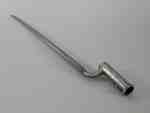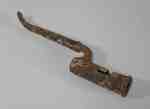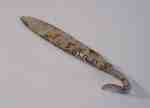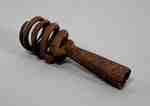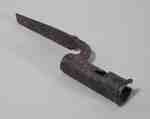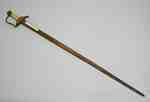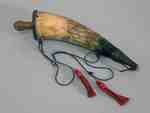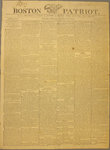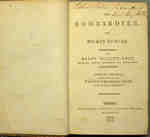Results
- This triangular bayonet is dated circa 1812 and has the distinctive markings “S. Chambers” and “46 (Crown)” on the blade. A bayonet was designed to fit on the muzzle of a rifle or musket barrel, makiThis triangular bayonet is dated circa 1812 and has the distinctive markings …
- This bayonet would have been designed to fit on the muzzle of a rifle or musket barrel, making it into a close range weapon. There is an inscription near the socket that reads “US, F.B.” A bayonet woThis bayonet would have been designed to fit on the muzzle of …
- This is a portion of a bayonet that would have been designed to fit on the muzzle of a rifle or musket barrel, making it into a close range weapon. The socket is complete and the blade has been bent.This is a portion of a bayonet that would have been designed …
- This is a portion of a bayonet that would have been designed to fit on the muzzle of a rifle or musket barrel, making it into a close range weapon. The socket is complete. However, approximately 2/3This is a portion of a bayonet that would have been designed …
- This is a portion of a triangular bayonet that would have been designed to fit on the muzzle of a rifle or musket barrel, making it into a close range weapon. This would have been on arguably every sThis is a portion of a triangular bayonet that would have been …
- This is the tip of a triangular bayonet that would have been designed to fit on the muzzle of a rifle or musket barrel, making it into a close range weapon. This would have been on arguably every solThis is the tip of a triangular bayonet that would have been …
- This linen bag features red stripes on a white background. The bag was used to carry flints for a flintlock musket. This type of bag was used from the Revolutionary War until 1820. Further research iThis linen bag features red stripes on a white background. The bag …
- This triangular bayonet is dated circa 1810-1820 and has the distinctive markings “J. Hill, (Crown) 19” on the actual blade and “110 1 G DS” on the base. A bayonet is a steel blade that is designed tThis triangular bayonet is dated circa 1810-1820 and has the distinctive markings …
- This triangular bayonet is made of iron and would have been used on a musket. A bayonet is a blade that is designed to fit on the muzzle of a rifle or musket barrel, making it into a close range weapThis triangular bayonet is made of iron and would have been used …
- This iron shell hook is a spring or coil-like shape with a short handle. The length of the coil is 8.5 cm and the handle is 12.5 cm. It was used by the artillery to clean the barrels of cannons durinThis iron shell hook is a spring or coil-like shape with a …
- These flintlock pistols are made of silver and wood. The pistol features many designs, including an acorn, a rose, a lion, an anchor and a crown. One of the pistols is believed to have belonged to HeThese flintlock pistols are made of silver and wood. The pistol features …
- This is a bayonet socket with a portion of the blade attached that was discovered in the Niagara River. A bayonet is a steel blade that is designed to fit on the muzzle of a rifle or musket barrel, mThis is a bayonet socket with a portion of the blade attached …
- This is a fragment of a triangular bayonet blade, dated from the War of 1812-1814, that was discovered in the Niagara River. A bayonet is a steel blade that is designed to fit on the muzzle of a riflThis is a fragment of a triangular bayonet blade, dated from the …
- This sword is made of metal and ivory with the blade measuring 81 cm and the handle 13 cm. It is a British regulation issue sword, circa 1796-1820, that could have been used by local militia troops dThis sword is made of metal and ivory with the blade measuring …
- This is a polished powder horn, dated 1812-1814, with a wooden fitted end and cork screw. It also has a brass spout and red tassels on blue rope for carrying. It is believed to be from the Royal ArtiThis is a polished powder horn, dated 1812-1814, with a wooden fitted …
- This sabre is made of metal, leather and wood. Along with its scabbard, the sabre was made by Woolley, Deakin, Dutton, & Johnson, as it is inscribed on one end of the scabbard. This scabbard is madeThis sabre is made of metal, leather and wood. Along with its …
- This is an officer’s sword that has the inscription “Capt’n Daniel Servos, Butler’s Rangers 1778” on its scabbard. The hilt is silver and green with an eagle on the pommel. The sword was donated to tThis is an officer’s sword that has the inscription “Capt’n Daniel Servos, …
- This is an ammunition chest made of wood, canvas and iron, and measures 272.5 x 56.3 x 52.5 CM. It has a curved lid covered with canvas with iron strapping, and angled iron on the four corners with iThis is an ammunition chest made of wood, canvas and iron, and …
- A semi-weekly paper that began in 1809 and ceased in 1816. Its succeeding title was the Boston Patriot and Morning Advertiser. Publishers included: Everett & Munroe, 1809-Mar. 7, 1810; Isaac Munroe,A semi-weekly paper that began in 1809 and ceased in 1816. Its …
- A practical military manual for officers in the Royal Regiment of Artillery. It combines training and field service manuals with lists of equipment, weights, dimensions, and equipment accuracy and peA practical military manual for officers in the Royal Regiment of Artillery. …
When selecting an individual record or object, you will move
to the website of the heritage institution that houses the item.
To return to the search or results pages, select "Back", "Results" or "New Search".
 This project was made possible with the support of the Department of Canadian Heritage
This project was made possible with the support of the Department of Canadian Heritage
through the Canadian Culture Online Strategy.
to the website of the heritage institution that houses the item.
To return to the search or results pages, select "Back", "Results" or "New Search".
 This project was made possible with the support of the Department of Canadian Heritage
This project was made possible with the support of the Department of Canadian Heritage through the Canadian Culture Online Strategy.






